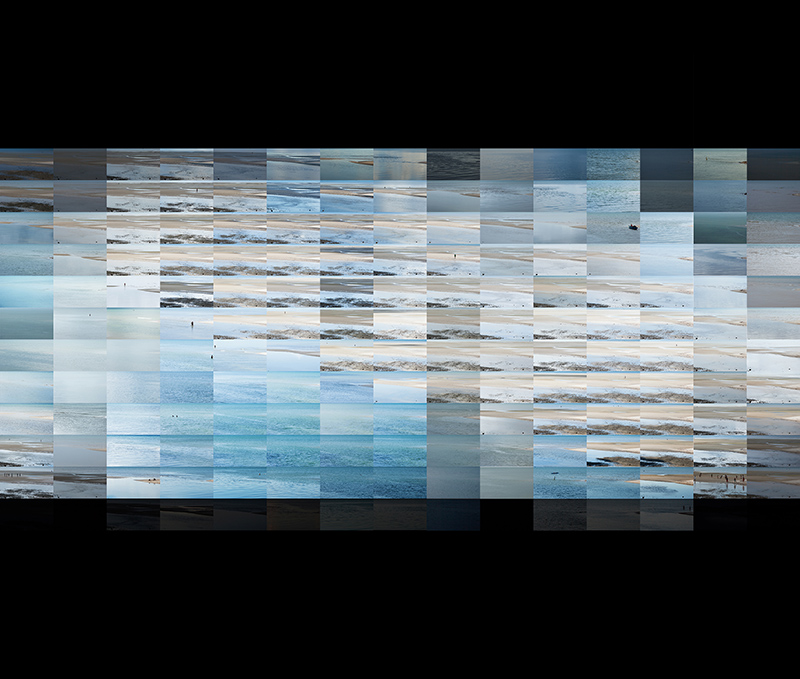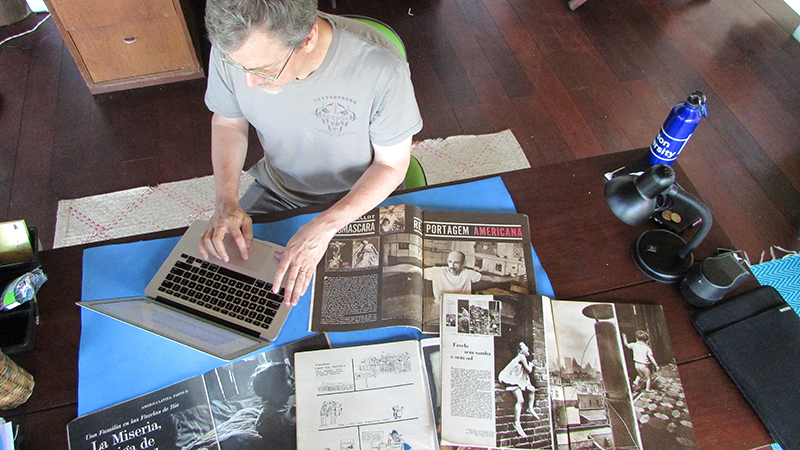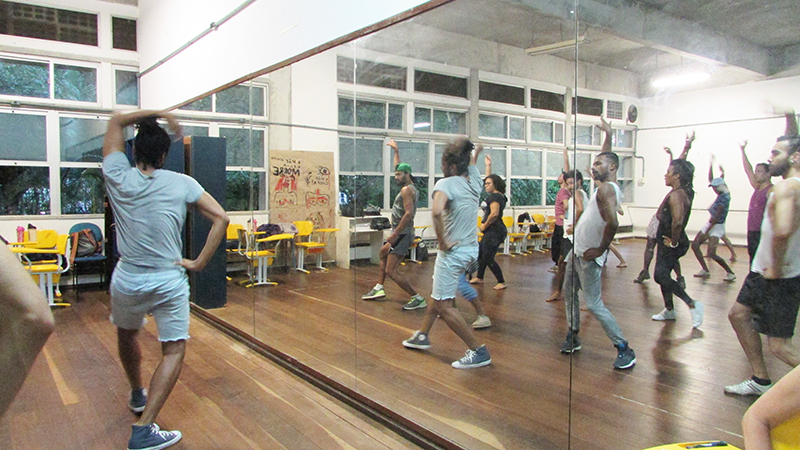Click here to learn more about what other Sacatar Fellows accomplished during their residencies as recorded in our Annual Reports
Polish novelist Joanna Bator during Sacatar Open Studios Day. Photo by Marcelo Thomaz, 2017“I am a novelist…My process is very spontaneous. When I have a first sentence, the story is on. So I was hoping for the “first sentence” to be created during Sacatar residency…I have accomplished much more than I dared to plan. I am going back with 3/4 of my new short novel (100 pages written in 5 weeks at Sacatar!). Sacatar gave me the perfect environment to write a story…And certainly I have not dreamed about such an amazing flow! Thank you Itaparica! We shot a promo clip for my novel with Marija Stojnic and Kato Change. We have also started a very promising cooperation with other fellow Matthew Burgess. We will publish a children’s book together.”
Joanna Bator, Literature-Polish (Poland 2017)
“I came to work on my book..the fascinating cultural and social mix that is Bahia will inspire me in the future. I think I will probably be back to do more writing here over the next few years – as soon as I pick up a bit more Portuguese…”
Jori Lewis, Literature-English (USA 2017)

Kenyan musician Kato Change performing at Jam no Mam concert in Salvador, Bahia. Photo by Marcelo Thomaz, 2017
“I came to express my culture, and experience those around me, through music and collaboration…I was able to start composing 7 new songs for my new album, collaborate with the local musicians, learn Brazilian rhythms and figure out how they relate to African music. I also played a few really cool gigs in Salvador and recorded in local studios, shot a couple of music videos for my new project, built meaningful contacts for future collaborations and potentially returning to Salvador.”
Kato Change, Music (Kenya 2017 – through a partnership with Africa Centre)
“My intended project was a community oriented research that would result in a short doc or documentary miniatures about traditional music from Bahia (musica axé do candomblé, musica de capoeira, samba de roda, etc.)…Instead of bringing the project to an end with a small piece of work, my interests have significantly expanded and I feel I’ve opened a whole new chapter of research. I was surprised by how time passes differently here, and it took me a week or two to get tuned into Bahia’s rhythm. I hope I’ll be able to come back to Itaparica with some aditional funding and continue working on my documentary project.”
Marija Stojnic, Filmmaker (Serbia 2017)
“I came to Sacatar with several projects. The first was a half-finished picture book manuscript titled “The Bear and The Moon.” The second was a picture book biography of the radical nun Pop Artist, Sister Corita Kent. The third was a novel… My projects didn’t change too much…except for an unexpected twist: after sharing “The Bear and The Moon” with Joanna Bator, we decided to hatch a collaboration. Joanna translated my story into Polish, and then she wrote a companion piece to go with it. She had been approached by a prominent Polish children’s book publisher, and now we are submitting our collaboration for their consideration…I’ve never been able to work so consistently without interruption…I will miss it tremendously.”
Matthew Burgess, Literature-English (USA 2017)
“Meu projeto era desenvolver uma pesquisa em processo sobre a queda física de um corpo como metáfora de uma atual situação política. Logo ao chegar me deparei com um barco encalhado e com a experiência de passar muitas horas parado no mar a cada manhã, o que mudou o rumo do projeto. Dessa forma, tomei o falecimento no mar do artista Bas Jan Ader (conhecido por cair em todas as suas video-performances) como mote para o trabalho…perseguindo a hipótese de que ele não estaria morto e sim morando na Bahia. Ou seja, o projeto foi inteiramente alterado logo na chegada ao Instituto.”
Renan Marcondes, Performance (Brazil 2017 – in partnership with the Centro Universitário Belas Artes)
“My main task..was to develop through an experience of the environment of Bahia a context for the work and themes and narrative strategies of the novels of Jorge Amado, for a book of literary criticism I am writing called The Banterers…I was able to accomplish a large part of what I had set out to do in my proposal, while also experiencing things I had not anticipated – such as candomble and the egungun ceremonies, as also a different model of race relations from the North-America-centric one usually prevalent in the world – that have proved immensely valuable to me.”
Chandrahas Choudhury, author (India 2017)
“During my stay at Sacatar I planned to complete several writing projects. I found the environment so peaceful and conducive to work that I was able to accomplish all that I intended to do and a lot more. The tranquility and beauty of the environment at Sacatar were very inspiring and contributed greatly to my productivity.”
Ladee Hubbard, author (USA 2017)
“A residência Sacatar assim como os encontros com as pessoas de Itaparica colaboraram perfeitamente para o desenvolvimento do meu trabalho. Cheguei com uma idéia totalmente aberta, e pude colher um material riquíssimo ao longo dos dois meses de residência. Acho que precisarei de uma outra residência para construir o filme.”
Louise Botkay, filmmaker (Brazil 2017)
“…of course, I didn’t embark on the project I came with, how boring is that…No, the circumstances always upend the process…and I went with inspiration, perspiration and presentation…wonderful materials began appearing on my doorstep, giant palm sticks, weird roots, large palm peels…And with that, everything changed and the Myth/tick Sacatar Effect took hold…I developed a kinship with a few of the residentts which of course prodded me further into performance…I will get a movie out of it and…it renewed and refreshed my need for foreign cultures.”
Pat Oleszko, Multi-media artist, Returning Fellow (USA 2008 & 2017)

An example of LightWorks, a collage of photos taken every hour on the hour from the same spot for fifteen days by Seungjae Lee
“I started new approaches to my works, I started to collage my pictures more freely in form and expand time period longer for my LightWorks…Nature here is very related with moon. That made me try 15 days of LightWork…This kind of different approach was possible because this place is very safe place to try new things.”
Seungjae Lee, photographer (South Korea 2017)
“It was a second time for me in Itaparica and Sactar. I knew the place so my project was very much connected with area. I did a Ocean diary. Every day I would collect one or few things from the beach and print their photograms in old technique – cyanotype. Parallel I photographed tide cycle for 12 hours. Photos will be made in to a stop motion projection and used in common exposition with cianotypes.”
Vilma Samulionyte, photographer, Returning Fellow (Lithuania 2013 & 2017)
“When I arrived, I thought to work with clay, but as I started to know Salvador and Itaparica’s history I was really keen to work with other materials, sugar and cacao… I was able for the first time to develop a site-specific installation project, related to the environment and its historical heritage. I can definitely say this was one of the best experiences of my life… for the first time I really felt the urge and the curiosity to react with all my skills to the context and I realized that both installation and painting are really part of the very same process.”
Jessica Rimondi, visual artist (Italy 2017)
“O meu projeto consistia em acrescentar à minha série de Quadros a óleo “Affinities” (mulheres fazendo par com um animal) alguns, protagonizados por mulheres da Bahia e inspirados pelo local…As minhas expectativas foram não só cumpridas como em muito ultrapassadas: Reuni material e inspiração excelentes para a série de quadros… Consegui executar dois quadros a óleo relativamente grandes e complexos…Executei cerca de 30 desenhos, com cenas aqui vividas…Reuni material e experiência para um novo projeto, ligado ao Candomblé, projeto esse que muito me entusiasma, que já está a andar e que, creio, poderá vir a ser um projeto de sucesso – terei parcerias locais, Espero com ele poder deixar “raízes” na Bahia e em Sacatar.”
Maria Teresa Crawford Cabral, visual artist (Portugal > Germany 2017)

Paul Roth, director of the Ryerson Image Centre in Toronto, prepared an exhibition about American photographer Gordon Parks that traveled from Toronto, Canada, to the Getty Center in Los Angeles, California, and to the Instituto Moreira Salles in Rio de Janeiro and São Paulo. Photo by Marcelo Thomaz, 2017
“My project was to write two essays, an introduction and a lengthy historical essay, about a 1961 Brazilian project by the American photographer Gordon Parks…My stay here allowed me access to Brazilian newspaper and magazine articles from the 1960s, which greatly illuminated a number of aspects of the story I’m telling…Being at Sacatar and Itaparica was an enormous psychological and spiritual boon to my project. I had the time and presence of mind to be able to write; and I felt a connect to my subject in a way I would not have had I written the essays in Canada.”
Paul Roth, curator (USA>Canada 2017)

Jumatatu Poe held a J-sette workshop at University of Bahia School of Dance. Photo by Marcelo Thomaz, 2017
“The nature of my project was quite social, like my work typically needs to be. I knew coming in that I wanted to meet Black queer artists and activists in the region, but coming in I did not initially understand how absolutely crucial learning to communicate in Portuguese would be…My current ability to communicate in Portuguese would make it much easier to return to Brazil and continue what I really JUST started here – working on some ideas with Brazilian dancers around the convergences and divergences of Black queer dance forms from Brazil and the US.”
Jumatatu Poe, choreographer (USA 2017)
“My project was to create an African war shirt in honor of Maria Felipa de Oliveira in collaboration with local artisans. Yes, I accomplished what I planned. The incredible positive response to my project from the students and faculty of the Federal University of Bahia, and everyone I encountered in Bahia, was inspiring!…The generous Sacatar staff helped me all along my journey and helped build and collect all that was required for my installation on open studio day.”
Precious Lovell, visual artist (USA 2017)
“While in residence, I worked on a story that is part of my collection-in-progress about homelessness and gentrification in the U.S. I wrote 107 pages (and still counting!) of this story, which I discovered may actually be a novella…The story is about two rival painters, one of who chooses homeless teenagers as the subjects of her portraits. Because the story had so much to do with the visual arts world, it profited enormously from exposure to my fellow residents who are visual artists and/or professionally rooted in the world of art and museum curation. They generously let me pick their brains—about everything from what they use to clean their brushes to the particularities of planning an exhibition and finding gallery representation to the trends, creative and economic and cultural, that shape the contemporary arts landscape—and observe their processes firsthand, which was invaluable in terms of fleshing out my story’s milieu and my characters’ inner and outer worlds…I believe that the setting of Itaparica and Sacatar—its ambience, its otherworldly beauty, its peerless colors and sounds and animals—seeped into the fabric of the story and helped inspire me as I tried to describe characters whose response to the sensory world around them is hyper-sensitized and almost unbearably intense. Moreover, the peace and tranquility of the location enabled me to concentrate and immerse myself in a writerly trance with much greater ease than usual. Whenever I got stuck, I would go walk across the beach for an hour, and would inevitably see something during my walk that would jolt me out of my over-analytical state and get me excited about starting again.”
Suzanne Rivecca, author (USA 2017)
Philip Boehm (USA), 2016
“Here I am back in Brasilia, after an easy trip, with my head still in Sacatar. Arriving home I spent a long moment recalling the days I was in Itaparica and I was overwhelmed by a great feeling of gratitude. It was light and very beautiful. Gratitude for having lived and received so many things in these days of Bahia. These things I can not name because they live outside words. And I did not know that even “receiving” is something that is learned, and to receive it also takes courage. Bahia taught me to receive. It taught me to look in silence. It taught me to wait. It taught me that it is possible to live mysteries without naming or defining them. Bahia taught me that the force is in the culture, it is in the people, it is in the nature. Yesterday, before bed, I felt that something had changed in me. In the words of the character and warrior Maria da Fé, from the novel by João Ubaldo: “Go, live and learn.” I lived and learned in Bahia, I lived and learned Bahia.”
Virgilio Neto, Brasil, 2016 in partnership with FUNARTE
“Bahia itself energised and added other dimensions to my work that I couldn’t have even dreamt of. The Instituto Sacatar itself was a dream in every single aspect, it is amazing to think that in this upside down world we live in, perfect pockets of space and support and creation like Sacatar exist.”
Nana Ayim, Ghana 2016 (in partnership with Africa Centre)









